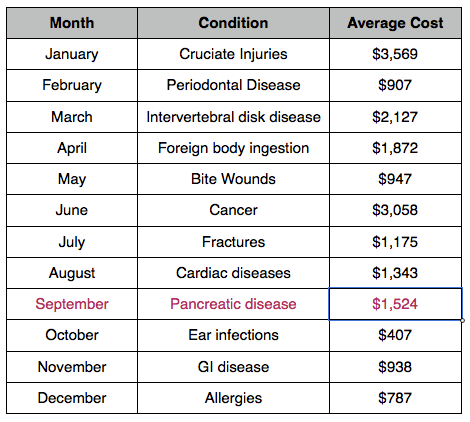Petplan Pet Insurance Company looked at 2016 claims data to determine the most common condition for which claims were submitted by month. For September, it was pancreatic diseases in dogs and cats.
 Source: Press Release
Source: Press Release
Exocrine Pancreatic Insufficiency
This syndrome is caused by a lack of digestive enzymes being secreted by the pancreas. This can occur in young animals and it is suspected that it may be inherited particularly German Shepherd dogs. The disease can also occur later in life secondary to repeated bouts of pancreatitis that destroys the cells that secrete these enzymes.
Because the food eaten by the pet isn't being properly digested and absorbed, it results in weight loss, a failure to thrive, poor hair coat quality, and gastrointestinal signs - usually chronic diarrhea despite a good or even ravenous appetite.
Your veterinarian may want to look at the diet you are feeding the pet as well as checking for intestinal parasites as the first steps to finding the cause of the symptoms. Other diagnostic tests that may be needed are:
- blood and urine screen to look for non-gastrointestinal causes
- PCR tests or cultures to look for gastrointestinal infections
- PLI test to check for pancreatitis
- TLI test (more specific) for pancreatic insufficiency
- tests to measure folate (Vit B9) and cobalamin (Vit B12). Low folate and cobalamin levels are sometimes seen in chronic GI diseases in both dogs and cats
- abdominal ultrasound to look specifically at the liver, gall bladder, pancreas and GI tract
- biopsy of pancreas and/or GI tract
The primary treatment is supplementation with pancreatic enzymes by adding a powder to your pet's food at each feeding. If tests reveal a low folate or cobalamin, these vitamins will need to be supplemented. Sometimes an antacid like Pepcid AC or Omeprazole may be needed to help protect the enzymes from stomach acid. Often, a special therapeutic gastrointestinal diet may be needed to help control the symptoms.
Obviously, the diagnostic workup that may be required to diagnose pancreatic insufficiency and lifetime treatment with a pancreatic enzyme supplement and feeding a therapeutic diet can be expensive. Pet insurance can help pay for these expenses. Be sure to buy a policy that reimburses at least part of the costs of a therapeutic (prescription) diet.
Pancreatitis
Pancreatitis (inflammation of the pancreas) occurs primarily in middle-aged to older dogs. Sometimes pancreatitis can be seen together with diabetes, Cushing's disease, hypothyroidism, or hyperlipidemia. Another common association is dietary indiscretion - particularly feeding people food high in fat.
Symptoms are lethargy, loss of appetite, vomiting, abdominal pain, diarrhea. Very mild bouts may not need medical intervention. Severe bouts can be life-threatening and require hospitalization and intensive care. Treatment usually consists of IV fluids, anti-nausea medication, pain medication and a special therapeutic diet.
Pancreatitis can sometimes be difficult to diagnose. An elevation of pancreatic enzymes (amylase and lipase) can be seen on a basic blood screen, but these are not specific enough to diagnose pancreatitis. The more specific test (PLI) and abdominal ultrasound are often needed for a more definitive diagnosis.
Some pets, particularly cats, can develop chronic pancreatitis. Pancreatitis in cats is often associated with inflammatory disease in the liver and GI tract (known as "triaditis"). Diagnosis and treatment is similar to the disease in dogs, but when treating cats, it is important that cats eat because going more than a few days without eating can lead to hepatic lipidosis (fatty liver) which can have a prolonged course of treatment. In cats that refuse to eat, either appetite stimulants or inserting a feeding tube may be necessary to make sure the cat receives proper nutrition.
Here are some examples of claims for pancreatitis (***not meant to be an endorsement of these companies):
